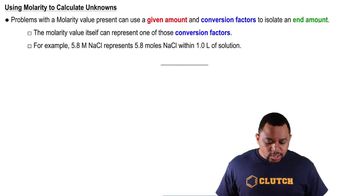(b) Which will contain the greater number of moles of potassium ion: 30.0 mL of 0.15 M K2CrO4 or 25.0 mL of 0.080 M K3PO4
Indicate the concentration of each ion present in the solution formed by mixing: (a) 42.0 mL of 0.170 M NaOH with 37.6 mL of 0.400 M NaOH.
 Verified step by step guidance
Verified step by step guidance
Verified Solution
Key Concepts
Molarity

Dilution

Ion Concentration Calculation

Indicate the concentration of each ion or molecule present in the following solutions: (b) 1.3×10−2 M MgSO4
Ignoring protolysis reactions, indicate the concentration of each ion or molecule present in the following solutions: (d) a mixture of 45.0 mL of 0.272 M NaCl and 65.0 mL of 0.0247 M (NH4)2CO3. Assume that the volumes are additive.
Indicate the concentration of each ion present in the solution formed by mixing: (b) 44.0 mL of 0.100 M Na2SO4 with 25.0 mL of 0.150 M KCl
Indicate the concentration of each ion present in the solution formed by mixing: (c) 3.60 g KCl in 75.0 mL of 0.250 M CaCl2 solution. Assume that the volumes are additive.
(b) If you take a 10.0-mL portion of the stock solution and dilute it to a total volume of 0.500 L, what will be the concentration of the final solution?
